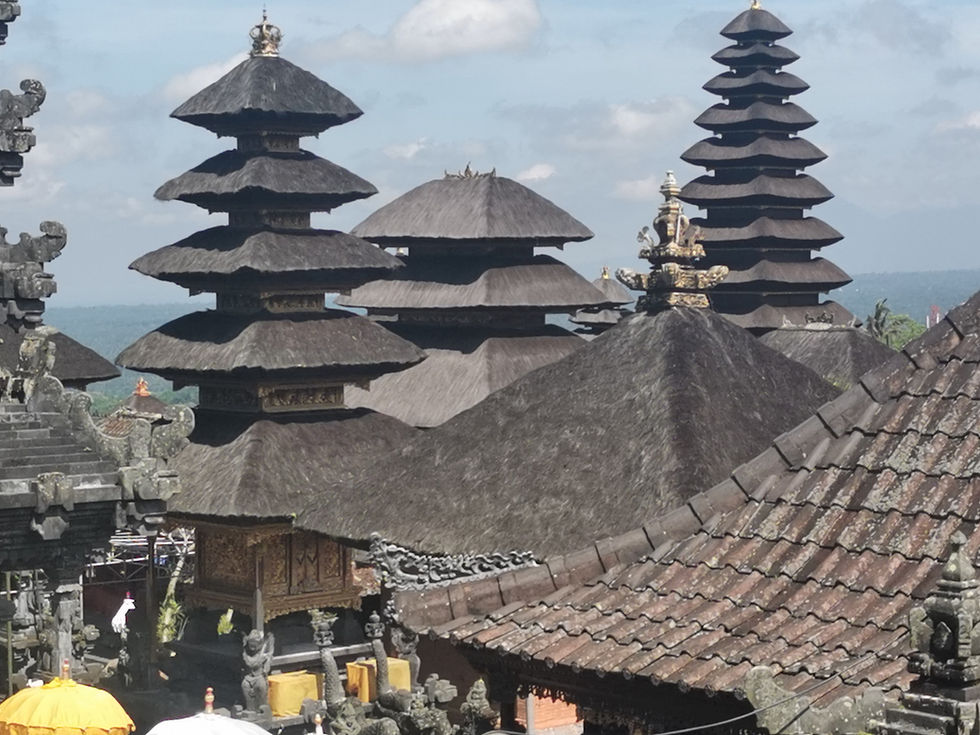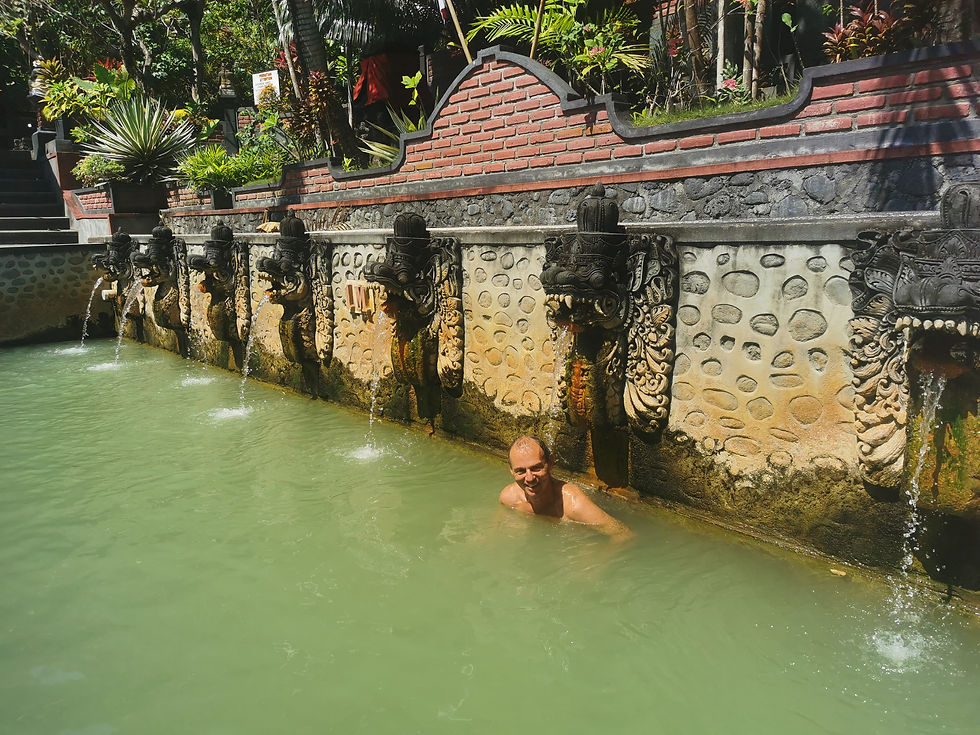
Bali has, for many years, become synonymous with either 'paradise', or rampant tourism. The island has been very successful at attracting visitors, with cheap flights from virtually everywhere. The younger generation come to Kuta/Seminyak to surf, or to enjoy the beaches and nightlife. Their parents and expats typically prefer the (slightly) more upmarket resorts of Sanur on the opposite coast. All appreciate the extremely low living costs.
It was only a short hop from Marina Del Rey, Lombok to Bali. However, my final leg, sailing alone, was not going to be straightforward. The Lombok and Baduk straights are infamous for strong currents and over-falls so it was necessary to time my departure to coincide with the tide flowing north to partially mitigate the south flowing current, on a day when the wind was not too strong. Even then, I had to (motor) sail on a NW heading for three hours to achieve enough northing to avoid being sucked down the Lombok strait and pass to the north of Penida Island before the tide changed.

The straits were full of fishing boats using brightly coloured sails, as well as the ferries zipping between the islands.

Once Skyfall was safely moored and put to bed in Serangan I departed for my week ashore in Bali. The island is not only a tropical paradise, but is also important both historically and culturally. As Islam spread through Asia, Bali became a refuge for Hindus. The island had nine kingdoms and, therefore, enough kings to commission many temples and palaces from the artists and artisans who had flocked to the safe haven.
I decided to base myself centrally, away from most of the bustle, in Ubud. The town is known for a 'monkey forest', a centre for artists and many yoga and 'wellness' centres. The town even has vegan restaurants! I met a German secondary school teacher who was spending the summer vacation doing a six week course to become a yoga teacher. Over lunch, she explained that she was also a trained psychiatrist and held sessions at school. I, jokingly, asked if her clients were mainly students or teachers. She smiled and replied that, actually, they were usually parents! The joys of bringing up teenagers.
From Ubud I could make daily excursions to explore the island before returning to relax by the pool.

The most important temple on Bali is Pura Agung Besakih or Besakih Great Temple. Built in the 8th century, it is actually 26 different temples on the same complex. My guide explained the symbolism associated with the different number of levels on the Pagoda roofs. Bali has two 'holy mountains', Agung and Batur. They are represented by eleven and nine levels respectively. The highest Hindu god, the Sun god, is represented by 7 levels. There are five important colours (red, black, white, yellow and yellow&white) which mark the four points of the compass and it's centre. A pagoda with five levels references these. Finally, a pagoda with three levels refers to Tri Murthi, which is the God trinity concept of Balinese Hindu Religion. Tri Murthi means ‘Tri’ = “three” and ‘Murthi’ = “realization of God”, so Tri Murthi means Three manifestations of God Almighty in accordance with his duties. Brahma as the Creator of life, Vishnu the Preserver and Shiva as destroyer.

Bali is incredibly fertile, thanks to the volcanic ash which has been regularly spewed over the land. Vast tracts of the island are dedicated to rice terraces and, in Tegalalang, they have been turned into a tourist attraction (see also top picture). There are restaurants, cafes, zipwires and swings over the valley, as well as countless objects intended to create photo opportunities (e.g. love chairs). However, there is also a well marked two and a half hour trek up the valley which leaves most of the tourists behind and allows you to enjoy the beauty of this unique landscape.

A short distance from the rice terraces, I found Gunung Kawi temple, which was built in the 11th century. It is not only a temple but also a funerary complex for Balinese kings. It spreads across both sides of a valley.

Tenanging traditional village lies in the north east of the island. It features 'original buildings' and demonstrations of traditional arts like weaving, coupled, of course, with the opportunity to buy souvenirs or have your picture taken in a variety of artificial photoshoot opportunities.

Close to Tenanging lies Puri Agung Karangasem, or water palace. As well as being a Royal Palace, it was once a seat of government. The buildings supposedly have a mixture of Balinese, Chinese and European influences. For me, the attraction was the grounds which provided a perfect setting to relax and enjoy a well earned drink and avoid the heat of the day.

There are waterfalls everywhere on Bali but Lonely Planet recommends exploring those in the north of the island. There is a hike which departs from close to Lake Tamlingan and which links several of them, depending on how much time and effort you wish to invest. Even though it was not the wet season, I found them pretty impressive.

Close to Lake Tamlingan is Lake Beratan. Ulun Danu Beratan Temple is located on two islands on the lake. Again, the grounds are beautiful. There were more Balinese worshippers using this temple than some of the much larger ones I visited. If I was to guess why, I believe it is due to the importance of water for 'cleansing of the spirit', important for reincarnation, and a lakeside position therefore has advantages.

Ceremonies were held on land adjacent to the two islands. The shrine is accessed via a Candi bentar, or ‘split gateway’. This is a classical Balinese and Javanese gateway and can be found at every temple and even as an entrance to houses. I have heard two explanations. One suggests the entrance denotes a mountain that has been split into two. Mountains are considered sacred by the Balinese. Thus, these intricately carved gates are seen as portals that connect the physical and spiritual world. Another says the two sides represent the two holy mountains, Agung and Batur, and that the portrayal echoes the sight of two hands held next to each other in prayer.

The furthest I ventured north was Banjar hot springs. The water is heated thanks to all the volcanic activity in the area. There are three pools, each at a different temperature. Thanks to it's relatively remote location it was not crowded at all.
There is also the opportunity for massage and use of a more modern wellness centre if desired. I could have spent at least half a day there, rather than the two hours I allocated.

I did venture into Sanur though. Friends David and Lyndsey have left their yacht, SV Kumo, in New Zealand and, after going home for a wedding, are spending the summer months exploring Asia as tourists. They flew into Bali from Vietnam whilst I was there and we met up in a Japanese restaurant which they knew. It was great to catch up on their travels and be able to offer some guidance based on my experience this year to help them plan their itinerary for 2025. And the food was excellent.

Overall, I was happy with my decision to morph from a live-aboard cruiser to just being a tourist ashore in a hotel. Sure, most of the sites I visited were set up as tourist attractions. Yet the entrance fees were nominal (e.g. at each waterfall there was somebody collecting US$0.10 from each hiker). Despite six days with a packed schedule, I reckon I saw less than 10% of the noteworthy temples, palaces and waterfalls. You could spend a lifetime here if you felt so inclined. However, my stay on Bali was easily the most stressful time in Indonesia. Simply because of the driving involved and the reckless nature of the traffic. At night around half the scooters did not have lights. Yet they still insisted on buzzing past on blind corners etc. The hustle and bustle was in complete contrast to the peace and serenity of, say, Banda Neira. And that is without visiting Kuta and it's nightlife!
For the next challenge, crossing the Indian Ocean to South Africa, I will be joined by Chris, my brother-in-law. More on our preparations next time.

ok
replika rolex submariner
replika rolex yacht master
Incredible photos and experiences Tom! Thank you for sharing them with us. Looking forward to hearing of your preparations for the Indian Ocean. Take care and enjoy. -Todd